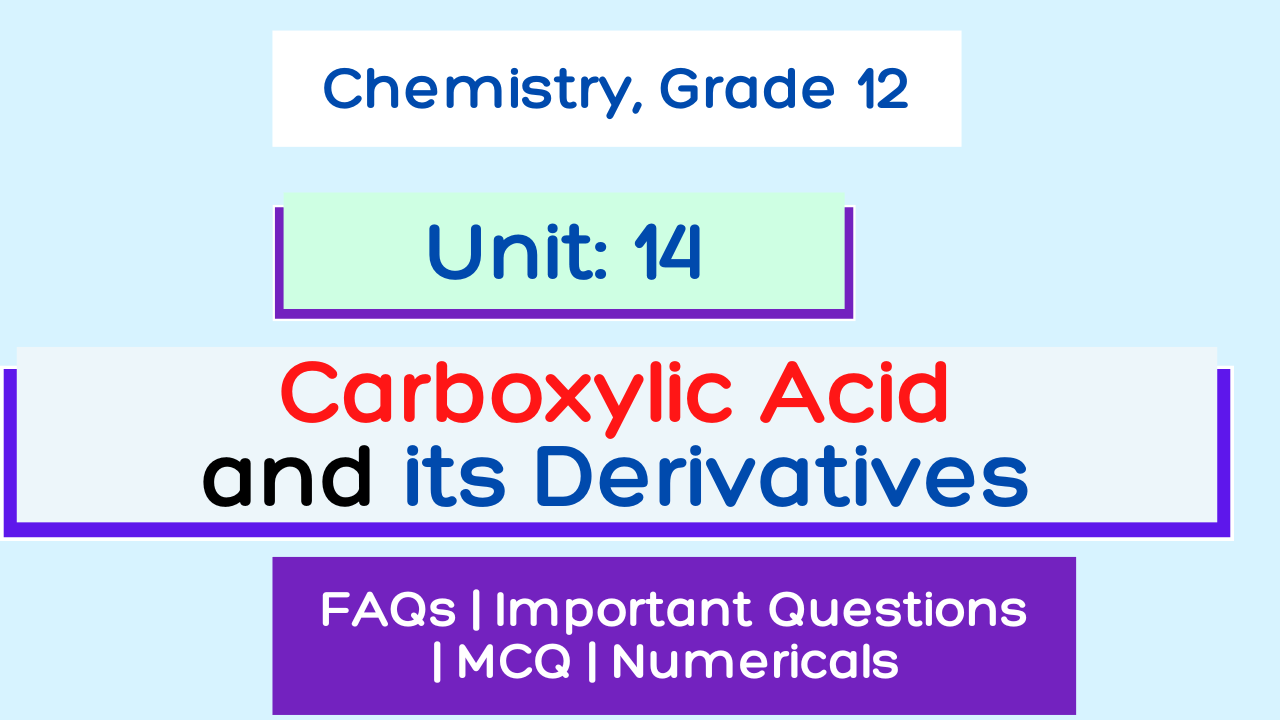Derivative of Carboxylic Acid – NEB Class 12 Organic Chemistry Notes
Derivative of Carboxylic Acid Syllabus
14.2 Derivatives of Carboxylic acids (acid halides, amides, esters, and anhydrides)
14.2.1 Preparation of acid derivatives from carboxylic acid
14.2.2 Comparative physical properties of acid derivatives
14.2.3 Comparative chemical properties of acid derivatives (hydrolysis, ammonolysis, amines (RNH2), alcoholysis, and reduction only)
14.2.4 Claisen condensation
14.2.5 Hofmann bromamide reaction
14.2.6 Amphoteric nature of amide
14.2.7 Relative reactivity of acid derivatives
NEB Class 12 Chemistry Syllabus
Derivative of Carboxylic Acid Introduction:
14.2.1 Preparation of Acid Derivatives from Carboxylic Acid
- Acid Halides:
- Reaction of carboxylic acids with thionyl chloride (SOCl₂), phosphorus trichloride (PCl₃), or phosphorus pentachloride (PCl₅).
- General equation: RCOOH+SOCl2→RCOCl+SO2+HCl
- Amides:
- Reaction of carboxylic acids with ammonia (NH₃) or amines (RNH₂).
- Dehydration of ammonium carboxylates: RCOOH+NH3→RCONH2+H2O
- Esters:
- Fischer esterification: reaction of carboxylic acids with alcohols in the presence of an acid catalyst.
- General equation: RCOOH+R′OH→RCOOR′+H2O
- Anhydrides:
- Reaction of carboxylic acids with acetic anhydride or by heating carboxylic acids.
- General equation: 2RCOOH→(RCO)2O+H2O
14.2.2 Comparative Physical Properties of Acid Derivatives
- Boiling and Melting Points:
- Analysis of intermolecular forces: hydrogen bonding, dipole-dipole interactions, and van der Waals forces.
- Comparison of boiling points: acid chlorides > anhydrides > esters > amides.
- Solubility:
- Solubility in water and organic solvents.
- Role of hydrogen bonding in amides and esters.
14.2.3 Comparative Chemical Properties of Acid Derivatives
- Hydrolysis:
- Mechanism and conditions for hydrolysis.
- Comparison of ease of hydrolysis: acid chlorides > anhydrides > esters > amides.
- Ammonolysis:
- Reaction with ammonia to form amides.
- General equation: RCOX+NH3→RCONH2+HX
- Reaction with Amines (RNH₂):
- Formation of substituted amides.
- General equation: RCOX+R′NH2→RCONHR′+HX
- Alcoholysis:
- Reaction with alcohols to form esters.
- General equation: RCOX+R′OH→RCOOR′+HX
- Reduction:
- Reduction to primary alcohols using reducing agents like lithium aluminium hydride (LiAlH₄).
14.2.4 Claisen Condensation
- Mechanism and Conditions:
- Reaction between two esters or one ester and one ketone in the presence of a base to form a β-keto ester or β-diketone.
- General equation: 2RCOOR′+Base→β-keto ester
14.2.5 Hofmann Bromamide Reaction
- Mechanism and Conditions:
- Conversion of primary amides to primary amines with one fewer carbon atom using bromine and a strong base.
- General equation: RCONH2+Br2+4NaOH→RNH2+Na2CO3+2NaBr+2H2O
14.2.6 Amphoteric Nature of Amide
- Amphoteric Behavior:
- Amides can act as both acids and bases.
- Explanation with examples of amides reacting with both acids and bases.
14.2.7 Relative Reactivity of Acid Derivatives
- Factors Influencing Reactivity:
- Electronegativity of substituents, resonance stabilization, steric factors.
- Order of reactivity: acid chlorides > anhydrides > esters > amides.
- Mechanistic Explanation:
- Nucleophilic acyl substitution reactions.
- Transition states and intermediates in the reaction mechanisms.
Derivative of Carboxylic Acid PDF:
Derivative-of-Carboxylic-AcidPages: 1 2

![NEB Class 12 Exam Routine 2081/2082 [2025]](https://iswori.com.np/wp-content/uploads/2025/02/neb-class-12-routine.png)

1 thought on “Carboxylic Acid and its Derivatives – NEB Class 12 Chemistry”